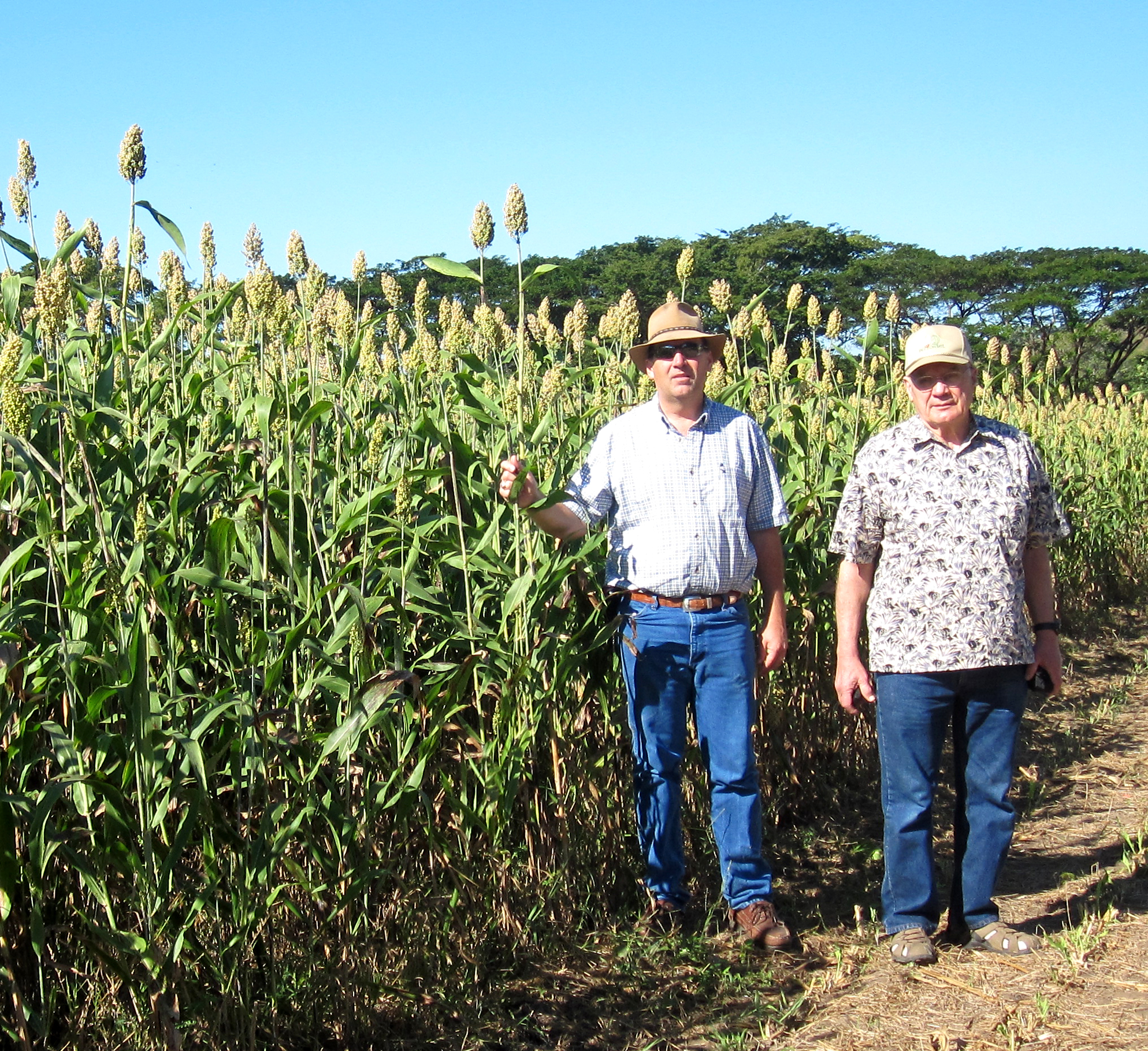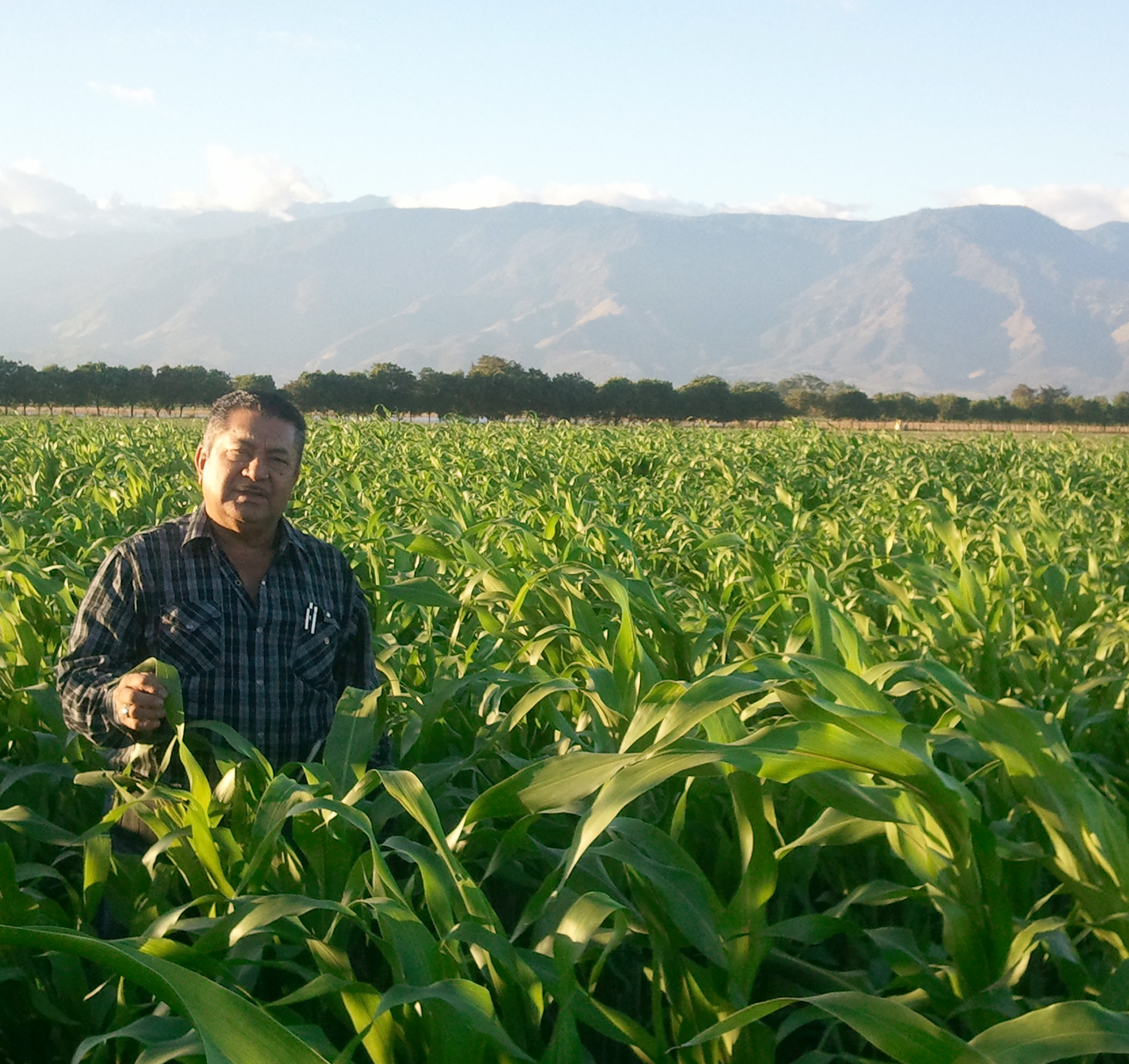|
Texas A&M breeder develops new sorghum variety for Central America
College Station, Texas, USA
December 20, 2013
A new brown midrib sorghum variety will help small farming and livestock operations in Central America, according to its developer, Dr. Bill Rooney, a Texas A&M AgriLife Research plant breeder in College Station.

Dr. Bill Rooney, Texas A&M AgriLife Research plant breeder from College Station, and Dr. John Yohe, former director the International Sorghum and Millet Collaborative Research Support Program, stand in a field of CI-0947 in El Salvador. (Texas A&M AgriLife Research photo)
Rooney and his team collaborated with Rene Clara and his colleagues at the Centro Nacional de Tecnologia Agropecuaria y Forestal in El Salvador in an effort to develop “CI0947bmr,” a brown midrib, dual-purpose sorghum for Central America.
The four-year project was funded by the U.S. Agency for International Development-funded International Sorghum and Millet Collaborative Research Support Program and the U.S. AID Feed the Future program.
Environmental conditions in Central America make the production of high quality forage challenging, Rooney said. The tropical environment hosts significant pests and pathogens that attack and reduce both yield and quality if they are not managed.

Officials present a bag of CI0947bmr sorghum seed to local producers during a ceremony in El Salvador. (Texas A&M AgriLife Research photo)
Also, the seasonality of rainfall limits forage production during the dry season. The rainy period occurs between mid-May and mid-July; this season is the most productive for crops. A second cropping season is completed in the transitional period of August to November.
The new sorghum variety was selected because it possesses the unique combination of agronomic adaptation, biomass and grain yield, as well as improved forage quality due to the presence of the brown midrib trait, Rooney said.
Productivity of the Central American livestock and dairy industries is often hindered by a lack of appropriate forage cultivars that provide sufficient quantity and quality forage or silage.

Rene Clara, partnering developer at the Centro Nacional de Tecnologia Agropecuaria y Forestal in El Salvador, stands in a field of CI0947bmr, a brown midrib, dual-purpose sorghum for Central America. (Texas A&M AgriLife Research photo)
“Our goal was to deliver a brown midrib sorghum variety that could be used for forage, silage and grain production in the Central America region,” Rooney said. “Many dairies in the region are small and rely on locally grown forages. Often that forage is sorghum, so it made sense to introduce or integrate the brown midrib trait into sorghum there.”
He said this newly developed variety is designed to provide the smaller livestock operations and dairies there with access to improved forage quality without sacrificing dry matter yield, grain yield or grain quality.
“The bmr mutations result in lower lignin (woody cellulose) content in the plant, providing higher forage digestibility while also increasing palatability,” Rooney said. “The animals eat more so you get improved rates of gain.”
“CI0947bmr” is a dual-purpose variety that can be grown exclusively as a forage or silage or as a grain crop with the crop residue used as forage, he said. In addition, the crop will ratoon and multiple crops can be produced from a single planting.
“This provides farmers with small acreage access to an improved forage variety that they can save the seed from year to year. It also has a good grain quality, so they can harvest the grain and use it separately or integrate it into the silage crop.”
While a number of brown midrib varieties were worked on across the region, the Texas A&M release was most widely adapted across Central America from Guatemala to Panama, Rooney said.
CI0947bmr was officially released by several National Agricultural Research Programs: in Guatemala as ICTA F947; in El Salvador as CENTA S-3bmr; and in Nicaragua as INTA CI0947. A future release is planned for Panama.
In Central America, seed of CI0947bmr is maintained and is available upon request from Centro Nacional de Tecnología Agropecuaria y Forestal, or CENTA, in San Andres, San Salvador, El Salvador. In the U.S., seed is maintained and available upon request from personnel in the Texas A&M University department of soil and crop sciences in College Station.
More news from: Texas A&M AgriLife
Website: http://agrilife.org/ Published: December 20, 2013 |
|
The news item on this page is copyright by the organization where it originated
Fair use notice |